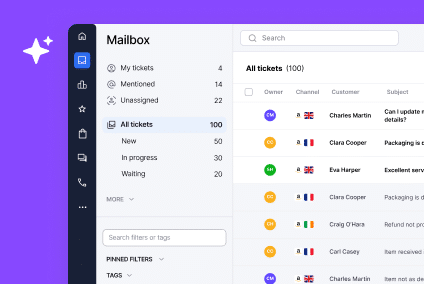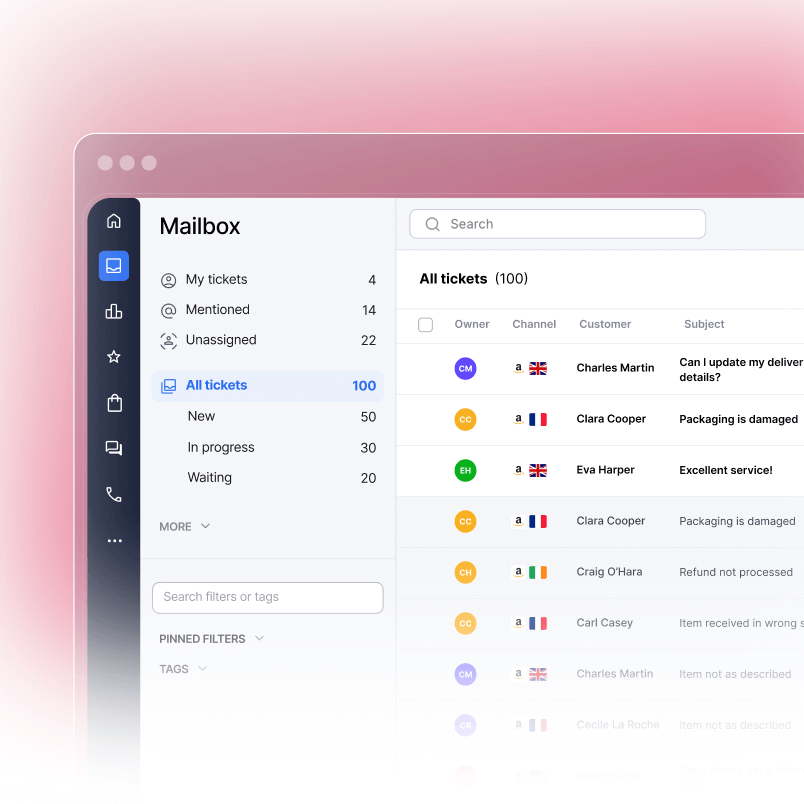Your customers expect answers fast. When someone lands on your Shopify store with a question about sizing, shipping, or a product feature, they want help now, not tomorrow. The support channel you choose directly impacts whether they buy, leave, or turn to a competitor.
This guide cuts through the noise and compares live chat, email, and phone support so you can build a support strategy that actually works for your business. We’ll break down the speed, scalability, and real costs of each channel, show you which customers prefer which option, and help you decide whether to go all-in on one channel or create a balanced mix.
How Support Channels Shape Shopify Store Performance
Your choice of support channels touches everything. Response time directly affects cart abandonment rates. Customer age influences which channels they trust. And your team size determines what you can actually handle.
Younger shoppers, especially Gen Z and millennials, prefer instant communication. They grew up texting and messaging friends. They expect the same from brands. Older customers often feel more comfortable picking up the phone or sending a detailed email.
Speed matters more than most sellers realize. 72% of customers expect a response within 30 minutes of reaching out, making first response time a critical factor for customer satisfaction. If you make them wait, they shop elsewhere. This is where channel choice becomes critical. Email typically takes 12 to 24 hours to reply. Live chat delivers answers in minutes. Phone support is fast but requires someone to pick up immediately.
Shopify’s native ecosystem supports chat-first workflows. Tools integrate seamlessly with your store, your product data, and your order history. This means faster, smarter support without the friction of switching between systems.
Live Chat: The Conversion Driver
Your customers expect answers fast. A customer viewing a product page has a question about materials or dimensions. With live chat, they get an answer in 60 seconds and complete the purchase. Without it, they close your store and search for the answer elsewhere. That’s a lost sale.
Why Live Chat Works for Conversions
Live chat addresses concerns in real time, right when customers are deciding to buy. It works because speed removes friction from the buying process.
Proactive Chat for Higher Sales
Live chat lets you be proactive. You can trigger offers for cart abandoners. You can offer help to first-time visitors. You can send targeted messages on specific product pages. These aren’t pushy tactics. They’re helpful interventions at exactly the right moment.
The Numbers Behind Live Chat
The data is compelling. Live chat results in a 48% increase in revenue per chat hour and a 40% increase in conversion rate. Customers who use live chat are 2.8 times more likely to complete a purchase, and 38% of customers spend more after engaging with live chat. Additionally, 40% of customers who engage with live chat are likely to make an online purchase, compared to significantly lower rates without it. These aren’t small improvements. This is transformative for revenue.
Scaling Live Chat Without Adding Staff
Live chat scales better than phone support. One team member can handle multiple conversations simultaneously. You can add chatbots to handle common questions like shipping times or return policies, freeing up your team for complex issues.
Shopify Integration Matters
Shopify store owners can integrate chat with tools like eDesk, which connects your support conversations with your order data, customer history, and inventory. This context makes your responses faster and more accurate. Check out the best help desk apps for Shopify to see how integration works in practice.
Email Support: The Workhorse for Complex Issues
Email isn’t dead. It serves a specific purpose that live chat and phone can’t fully replace.
When Customers Need Detailed Support
Email is where customers send detailed requests. A customer needs to explain a damaged item, request a refund, or ask about a custom order. They want to include photos, explain their situation fully, and receive a thoughtful response. Email lets them do that.
Documentation You Actually Need
Email creates a paper trail. Every message is documented. You can track what was promised, what was resolved, and what follow-up is needed. This matters for compliance, for team handoffs, and for disputing chargebacks.
How Email Scales With Your Team
Email scales to your team size. You don’t need live agents sitting around waiting for chat requests. Your team can batch their responses, handle email during slower periods, and manage volume predictably.
The Speed Trade-Off
The challenge with email is speed. Customers expect 12 to 24 hours for an email response, sometimes longer. If someone needs help today, email won’t cut it. This is why successful Shopify stores use email for post-purchase support, returns, and complex issues rather than for immediate pre-purchase questions.
Email Helpdesk Tools Add Structure
Tools like eDesk, Zendesk, and Gorgias add structure to email support. They turn email into a ticketing system. You can assign tickets, track SLAs, automate responses to common questions, and build a knowledge base that helps customers find answers before they email you.
Phone Support: Personal Connection at a Cost
Phone support is the most personal channel. It’s also the most expensive and hardest to scale.
The Power of Voice
When a customer hears a human voice, they feel heard. They trust that their problem will be solved. Phone support builds relationships that no chat or email can match. This is valuable for expensive products, for upset customers, and for VIP clients.
Why Phone Support Becomes Expensive
Phone support has hard limits. It requires staff sitting by phones during specific hours. If you offer 24/7 phone support, you need team members across time zones. Your costs multiply quickly.
The Scaling Problem With Phone
Phone support doesn’t scale. One representative can handle one customer at a time. If you have 100 inquiries an hour, you need 100 representatives on the phone simultaneously. Live chat handles 100 inquiries with 10 to 15 team members, depending on chatbot deflection.
How Most Shopify Stores Use Phone
Most successful DTC Shopify stores use phone support strategically, not as their primary channel. They offer it for customers who request it, for high-ticket sales, or for escalations from chat and email. They use a VOIP service like Aircall or Talkdesk to integrate phone data with their helpdesk, but they don’t rely on phone as their main support line.
Tools Built for Multichannel Support
eDesk for Marketplace Sellers
eDesk specializes in high-volume multichannel support for sellers on Amazon, eBay, Walmart, and Shopify. Your team gets one unified inbox with order data syncing in real-time. Response time trackers keep everyone accountable. The platform was built specifically for the challenges marketplace sellers face. You get SLA management, intelligent routing, and native marketplace compliance built in.
Gorgias for DTC Brands
Gorgias works best for DTC brands focused on Shopify. It connects Instagram, Facebook, email, and SMS with native Shopify integration. Macros help speed up responses. Intent detection flags urgent issues automatically. If your business is primarily direct-to-consumer, Gorgias offers strong workflow automation.
ChannelReply for Zendesk Users
ChannelReply layers marketplace support on top of Zendesk. It pulls marketplace orders into your Zendesk workflow. If you’re already invested in Zendesk, this bridges the gap without requiring a platform switch. This approach works well for enterprises already standardized on Zendesk.
How to Choose the Right Tool
The right choice depends on your channel mix. High-volume marketplace sellers benefit from eDesk’s specialization and marketplace-first design. DTC-focused brands find speed in Gorgias. Teams already using enterprise helpdesk software might layer on ChannelReply. When evaluating options, consider your channel distribution, team size, and growth plans.
Live Chat vs Email vs Phone: The Direct Comparison
| Channel | Speed | Scalability | Best For | Shopify Integration |
| Live Chat | Instant | High | Cart support, quick questions, FAQ deflection | Native integration available |
| Slow (12-24 hrs) | High | Complex issues, returns, documentation | All helpdesks support it | |
| Phone | Fast (manual) | Low | High-touch, emotional support, escalations | Indirect via VOIP apps |
Live chat wins on speed and scalability. Email wins on documentation and complexity. Phone wins on personal connection but loses on scale.
The right channel mix depends on your store’s needs, not on which channel sounds best. A store selling $2,000 watches needs phone support for consultations. A store selling $20 hats can win with live chat and email alone. A store selling $200 apparel benefits from all three.
Building Your Support Channel Strategy
Start with your customer type and buying process. If customers buy on impulse, live chat prevents cart abandonment. If customers research extensively, email documentation matters more. If customers drop big money, phone support builds confidence.
Match Your Channels to Your Products
Consider your order complexity. Simple orders need fast chat responses. Complex orders need detailed email documentation. High-value orders need phone consultations.
Align Your Tools With Your Team Size
Match your team size to your channels. If you have 2 support staff, live chat and email work. If you have 5, add phone. If you have 1, focus on live chat with automation.
The Winning Channel Structure
Use this framework: live chat for pre-sale support, email for post-sale support, phone for escalations and high-ticket customers. This balances speed, scalability, and team capacity.
Channel Strategy Checklist
Answer these questions to find your ideal channel mix:
What is your average order value? Is it under $50, $50 to $500, or over $500?
How many inquiries do you receive daily? Is it under 50, 50 to 200, or over 200?
What type of questions do customers ask most often? Are they simple (shipping times), moderate (size guides), or complex (custom orders)?
Do you have product complexity that requires phone consultation? Or are your products straightforward?
What time zones do your customers operate in? Do you need 24/7 support or business-hours-only?
How many support staff do you employ? This determines realistic channel capacity.
Answering these questions reveals your ideal channel mix.
The Right Tools for Your Shopify Store
Your tooling determines whether your support strategy actually works.
Live Chat Integration for Shopify
For live chat on Shopify, eDesk integrates directly with your store and your email helpdesk in one unified interface. This eliminates the need to jump between systems. Your team sees all conversations, chat context, order history, and customer data in one place. Other options include Tidio and Re:amaze, but eDesk’s Shopify integration is built to handle high-volume stores.
Email Helpdesk Systems
For email helpdesk support, eDesk offers ticketing, automation, and multi-channel support. Zendesk is a competitor but comes with higher costs and a steeper learning curve. The best ecommerce helpdesk software includes built-in Shopify integration, tag-based automation, and team collaboration features.
Phone Integration With Your Helpdesk
For phone integration with your helpdesk, services like Aircall and Talkdesk log calls to your support system. Freshcaller offers similar functionality at lower cost. The goal is capturing phone interactions in your helpdesk so nothing falls through the cracks.
Exploring Your Options
If you want to explore how other Shopify store owners handle their helpdesk setup, check out the best ecommerce helpdesk software guide or read about multi-channel fulfillment strategies that tie support channels to order workflows.
Consider also how automation layers on top. Learn about 3 time-saving customer service automation tips to see how you can reduce the volume hitting your team while still delivering fast responses.
Final Thoughts on Support Channel Selection
There’s no one-size-fits-all answer. Your support channels should reflect your customers, your products, your team, and your growth stage.
Most growing Shopify stores start with live chat and email. Chat handles the volume and converts browsers to buyers. Email handles returns, complex issues, and documentation. This combination is cost-effective, scales well, and improves customer satisfaction.
If you sell high-ticket items or serve a more traditional customer base, add phone support. If you sell fast-moving consumer goods, go deeper on chat automation and chatbot deflection.
Your channel strategy isn’t set in stone. Test what works. Track which channels generate the highest satisfaction scores and the lowest response times. Adjust as you grow.
The goal isn’t to offer every channel. The goal is to offer the right channels for your customers in a way that your team can actually deliver on. When you get that balance right, support becomes a competitive advantage instead of a cost center.
If you’re still weighing your options between live chat, email, and phone, remember that the best support strategy grows with your Shopify store. Start with what your team can manage, refine it based on performance data, and expand as your customer needs evolve. When every interaction feels fast, personal, and consistent, your support stops being reactive and starts driving revenue.
Take the next step toward streamlined, multichannel support—try eDesk free today
FAQs
Is live chat better than email for ecommerce?
It depends on context. Live chat is better for preventing cart abandonment and answering quick questions. Email is better for complex issues, returns, and creating documentation. Most successful stores use both.
Should I offer phone support in my Shopify store?
Only if your average order value is high, your customers expect it, or you’re selling consultative products. Most DTC stores win with chat and email. Use phone for escalations and VIP customers instead.
What’s the best live chat tool for Shopify?
eDesk integrates live chat directly into your Shopify helpdesk, so you manage chat and email conversations in one place. Tidio and Re:amaze are alternatives, but eDesk’s Shopify integration is built for stores at scale.
Can I automate Shopify customer service?
Yes. Chatbots handle 60% to 80% of common questions like shipping times, return policies, and product specs. This lets your team focus on complex issues that need human judgment. Automation paired with live chat is where most stores see the best ROI.
Should I hire more support staff or invest in better tools?
Start with better tools. A helpdesk system with automation and AI-powered deflection reduces the volume hitting your team by 20% to 40%. This buys you time before you need to hire. Once you’ve optimized your process, hiring becomes the next step.
How do I decide between live chat, email, and phone if I have a small team?
Start with live chat and email. Both scale with a small team. Chat requires 1 to 2 people to handle 50 to 100 daily inquiries. Email requires less active time. Phone requires someone always available, so skip it until you grow.
What’s the typical response time customers expect for each channel?
Live chat: under 2 minutes. Email: 12 to 24 hours. Phone: immediate pickup or callback within 1 hour. If you can’t meet these expectations for a channel, don’t offer it.




